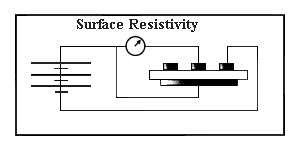| 用 MatWeb 登广告! | ||
| 越过59,000 以上, 金属、塑料、陶瓷和合成物的数据资料库。 | ||
|
主页 • 搜寻 • 工具 • 供应商 • 文件夹 • 有关我们 • 常用问题 • 登录 • |
||
| | | | | | |
|
||||
Surface Resistivity Testing of Plastics
The surface resistance of a plastic is, as the name suggests, the resistance to the flow of electrical current over its surface. This is in contrast to the volume resistivity (or simply electrical resistivity), which is the resistance to flow through the three-dimensional volume of a sample. The common test in the USA is ASTM D257; other test methods are IEC 93 - IEC 60093 and JIS K6911. The figure below, from Quadrant Engineering Plastic Products, illustrates the test geometry.
Control of environmental factors is important because the surface resistivity of a polymer can change rapidly in response to humidity changes. A thorough reporting of test results includes the temperature and humidity of the sample before and during the measurement. Low surface resistivity is important in applications where static electricity dissipation is required. Engineering plastics are inherently very good insulators with surface resistance values typically in the range 1014 to 1018 ohm in base resins. Decreased resisitivity (increased conductivity) is often imparted to plastics by additives such as conductive carbon fibers or by surface treatment of finished products. Bulk additives are preferred where permanence is a concern. The upper limit for surface resistivity of a polymer considered to be considered 'static controlled' is about 1012 ohm. The surface resistivity of metals is almost never measured because of their inherently high conductivity - static buildup is not a problem on bare metal surfaces - although the electrical resistivity through the volume of metals is key for many uses. |
|
订阅特级服务 高级先进 • 构成份 • 特性 • 材料类型 • 制造商 • 商标 • UNS号码 广告 • 递交资料 • 资料库许可证 • 网址设计管理 • 交易发行 供应商名单 • 单位转变 • 参考 • 新消息 • 链接站 • 协助 • 通讯 • 网址图示 • 常用问题 • 主页 |
||
| 请读关于材料数据的使用许可协议和我们的隐私权。询问或评论有关 MatWeb? 请与webmaster@matweb.com 联系。我们感谢您对 MatWeb的参与。
本站点由 Automation Creations, Inc. 设计和维护。这个网站的内容, MatWeb 的商标,与 "MatWeb" 由 Automation Creations, Inc.版权1996-2006拥有 。 MatWeb 意欲为个人使用 , 非商业用途。这个站点的内容、结果和技术数据,未经由 Automation Creations, Inc. 允许, 不可以被电子,摄影或实质上地再生产或自动化创作。 |
||
